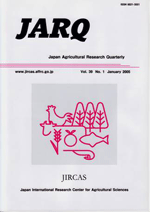The Effects of Day and Night Temperature on the Dry Matter Accumulation of Oriental Hybrid Lily ‘Siberia’ as they Relate to the Photosynthetic and Respiratory Characteristics
| ISSN | 00213551 |
|---|---|
| NII recode ID (NCID) | AA0068709X |

The net photosynthetic rate on a per-plant basis of the Oriental hybrid lily ‘Siberia’ was low at the leafing stage but increased rapidly at the visible flower bud and flowering stages. The range of 20 to 25°C was the optimum temperature for photosynthesis at the three plant developmental stages under PPFD of 700 to 850 µmol photons m-2s-1. The respiration rate increased with the increasing temperature quadratically (in aerial plant parts) or exponentially (in underground parts). The ‘Siberia’ plants were grown under three day temperature (DT) conditions of 28°C, 24°C or 20°C, with a night temperature (NT) of 15°C or three NTs of 25°C, 20°C or 15°C, with DT of 25°C in the growth chambers. At the flowering stage, the plants grown under low DT of 20°C had a high dry weight (DW) of the total plant, flowers, bulb, and roots, and a high DW/fresh weight (FW) ratio of the leaves, stem, and bulb. The plants grown under low NT of 15°C had a high DW of the total plant and stem, and a high DW/FW ratio of the leaves and bulb. The plants that were grown under a low NT had a long stem length by the positive DIF effect, which was supported by sufficient dry mater accumulation. The plants grown under low DT of 20°C showed a high relative growth rate (RGR) and net assimilation rate (NAR) from planting to flowering, whereas the NT condition did not affect the RGR or NAR.
| Date of issued | |
|---|---|
| Creator | Katsuhiko INAMOTO Kaori NAGASUGA Takayoshi YANO Hiroko YAMAZAKI |
| Subject |
cut flower quality growth analysis positive DIF effect |
| Available Online | |
| NII resource type vocabulary | Journal Article |
| Volume | 50 |
| Issue | 2 |
| spage | 143 |
| epage | 152 |
| DOI | 10.6090/jarq.50.143 |
| Rights | Japan International Research Center for Agricultural Sciences |
| Relation | : J-STAGE |
| Language | eng |
